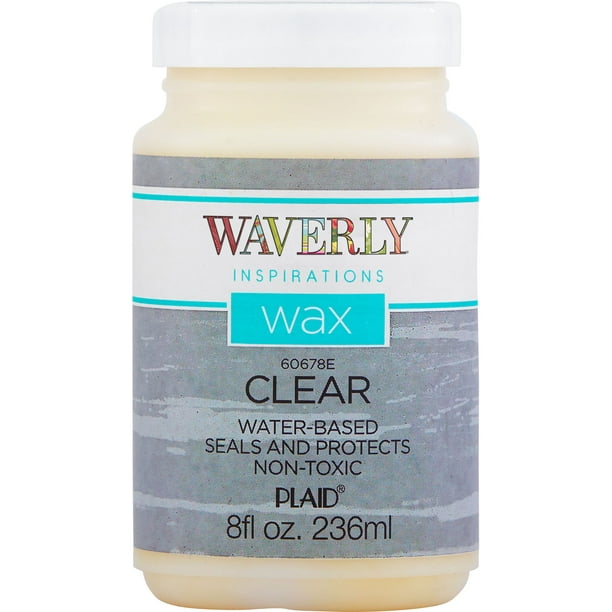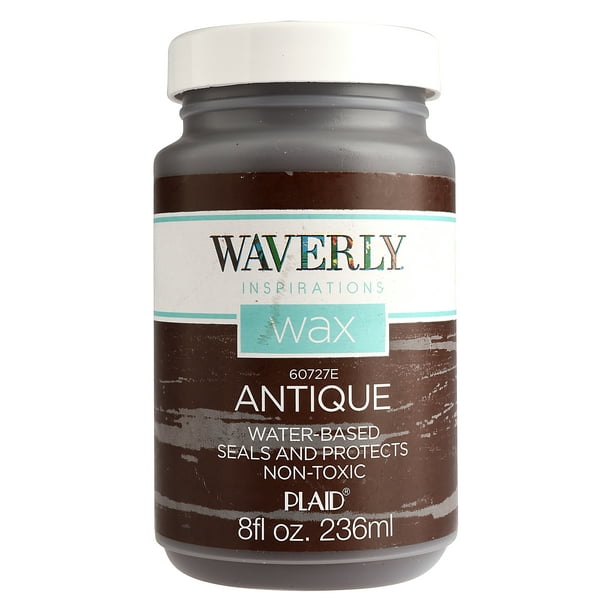Glaze VS Wax Over Chalk Paint
Chalk painting is one of the most popular painting techniques due to its versatility and ease of use. But when it comes to finishing your project with an antiqued look, you may be faced with a decision between two different approaches: glaze vs wax over chalk paint. Knowing which finish will work best for your specific project requires an understanding of both finishes and how they differ from each other.
In this article, we’ll take a look at what chalk paint is and how to apply both glaze and wax finishes over it, as well as provide a comparison of glaze vs wax so that you can make an informed decision about which one is right for you.
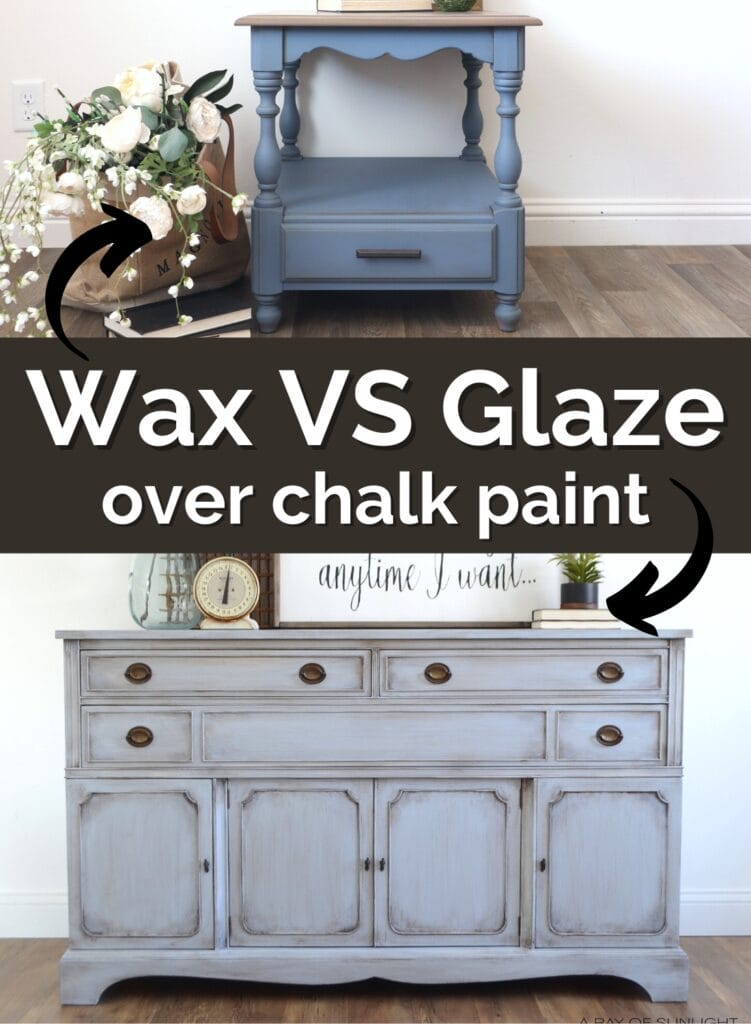
Glaze and wax are two popular antiquing finishes that can be applied over chalk paint. Each has its own advantages and disadvantages, so it’s important to understand the differences between them before making a decision.
With glaze, you get a more durable finish with a poly topcoat that dries quickly and works well with polyurethane topcoat.
Wax is quicker to apply but not as durable, and if you don’t like it, you have to remove the wax before painting again.
Keep reading to learn more about these two finishes and make an informed decision on which product is best for you!
As an Amazon Associate, I earn from qualifying purchases. I also may earn from other qualifying purchases with other companies or get free product to review and use. All opinions are my own.
What is Chalk Paint?
Chalk paint is made of a mixture of chalk, pigment, and binder that results in a chalky finish.
Unlike traditional paint, it is intentionally formulated to have a textured and weathered look once dry, though you can create a smooth brush free look with it as well.
One of the biggest advantages of using chalk paint is its ease of use. Chalk paint companies say that it does not require any sanding or priming before application, and dries quickly.
As an added bonus, it comes in a wide range of colors and can be further customized with different finishes.
Chalk paint is particularly favored by furniture painters who want to complete their projects in a timely fashion without spending too much time on the preparation or finishing stages.
How to Chalk Paint Furniture
One important thing to know about chalk paint is that you shouldn’t just start painting on any surface without any prep work. Learn How to Prepare Furniture For Painting here.
If you want the paint to stick really well, it’s a good idea to do something called scuff sanding before you start. Learn more about The Importance of Sanding Before Painting Furniture here.
Another downside to chalk paint is that it won’t block stains on the surface you’re painting. So you still should prime before painting with chalk paint to Stop Stains from Coming Through Paint.
Check out The Best Primers for Painting Furniture (and How to Choose the Right One) here.
When you’re painting with chalk paint, it’s usually pretty thick and goopy. So you might see some brush marks or texture when it dries.
Learn more about How to Paint Furniture Without Brush Marks here.
If you want your chalk paint to last a long time and not get messed up too easily, you need to put something on top of it to protect it.
You can choose either wax or polyurethane for this. Without that protection, you’ll need to touch up your paint pretty often. Check out the best Topcoats for Painting Furniture here.
Even though chalk paint has some downsides, a lot of people still like to use it because it’s easy to find and easy to use.
Learn more about How to Chalk Paint Furniture here.
Glaze Over Chalk Paint
Glazing over chalk paint is an easy and efficient way to add depth, texture, and character to furniture pieces.
Glaze finishes provide a protective layer that makes the piece more durable while adding a unique look.
With glaze, you get a more durable finish with a poly topcoat that dries quickly and works well with polyurethane topcoat. However, it does take longer to glaze and it takes some skill and precision to apply glaze properly.
Pros:
- More durable with a poly topcoat
- Dries quickly
- Works well with a polyurethane topcoat
- Does not involve wax – I don’t like waxing chalk paint, and how it feels, how it dries or holds up on furniture
Cons:
- Have to wait for chalk paint and topcoat to cure for 24 hours
- Takes a little more skill and precision to glaze
- Have to topcoat the glaze for maximum durability
How to Glaze Over Chalk Paint
To achieve a beautiful glazed finish on your chalk-painted furniture, it’s important to follow a few steps. Here is how you can successfully glaze over chalk paint.
First, apply a water-based polyurethane sealer to the topcoat of chalk paint. This will slow down the glaze’s absorption and make it easier to control.
Let it dry for at least 24 hours before beginning to glaze.
When applying the glaze, use a brush or lint-free cloth, ensuring to work it into all the crevices and corners.
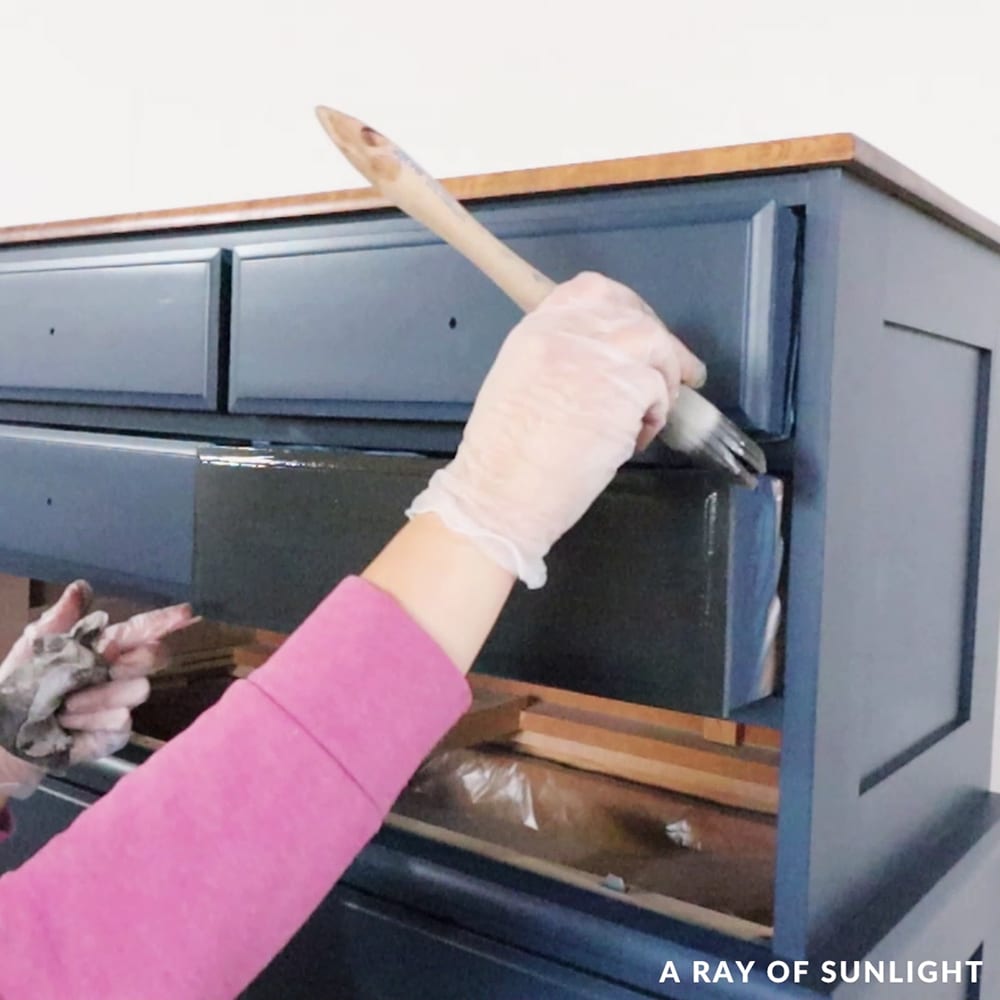
Once applied, use baby wipes or a damp, lint-free rag to remove any excess glaze and create the desired effects.
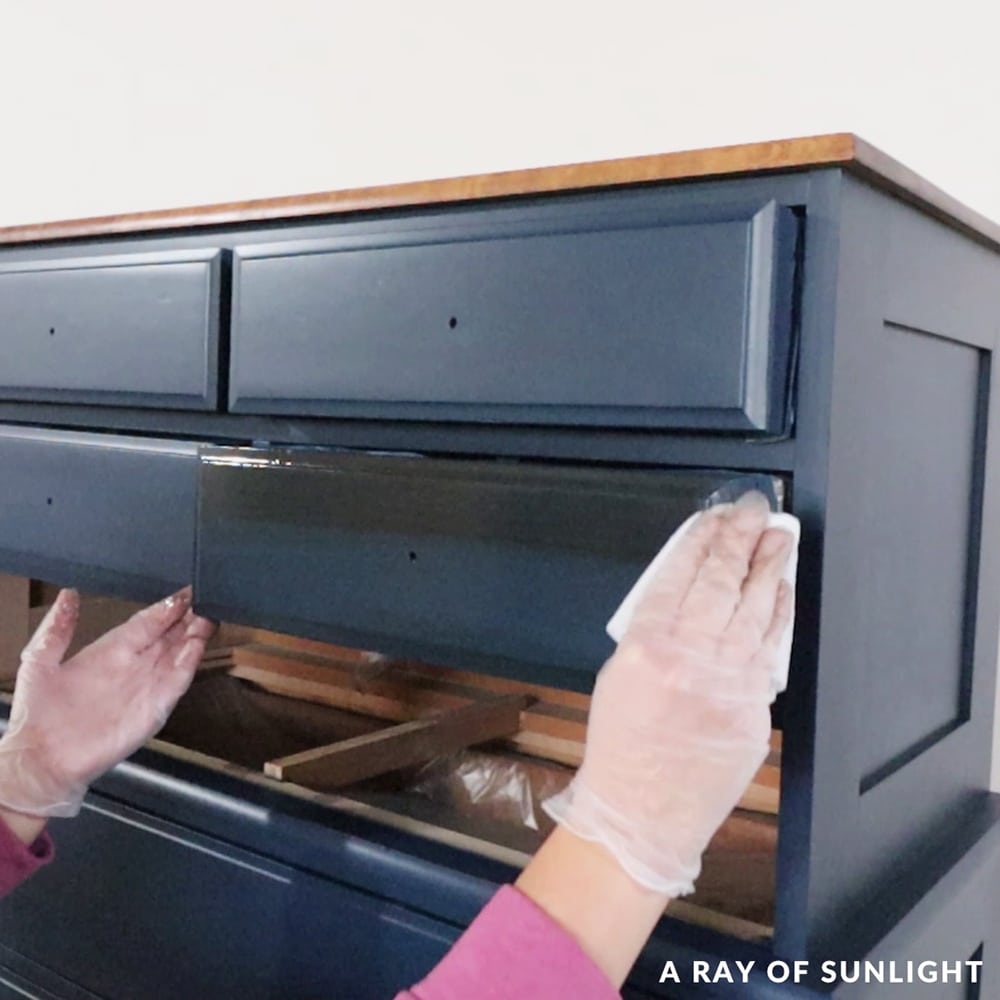
You can add additional layers of glaze, letting the glaze dry for at least a few hours between coats. You can also mix clear glaze with the chalk paint you used, to hide some of the antiquing glaze.
To protect the finish, apply multiple coats of water-based polyurethane, and let the final coat cure for at least 24 hours before using your newly glazed piece of furniture.
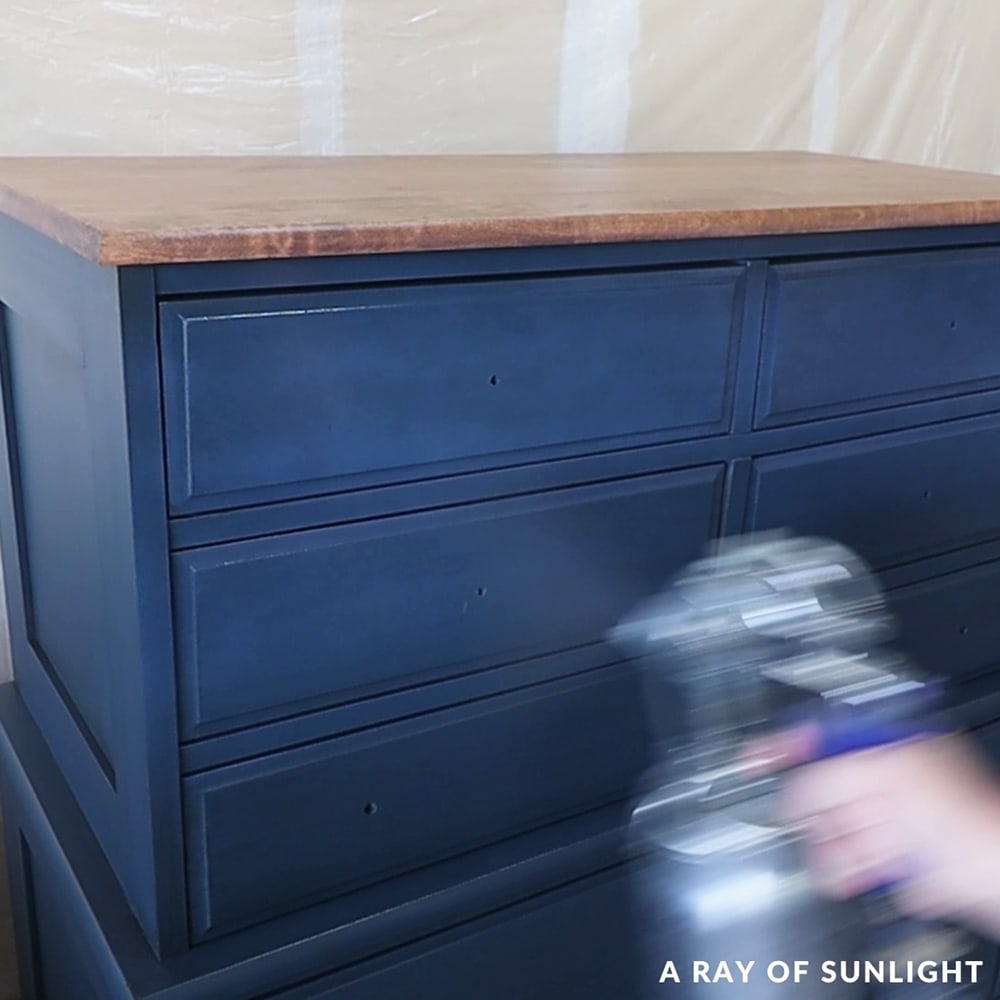
Check out this How to Glaze Over Chalk Paint makeover to see how I used glaze over chalk paint.
Wax Over Chalk Paint
Waxing over chalk paint is another easy and cost-effective way to add character and protection to furniture pieces.
This method involves applying a clear wax base coat first, followed by dark wax in areas where desired. The result is a unique, textured finish that provides both aesthetic appeal and added durability.
Or read through this detailed guide on How to Apply Waverly Wax Over Chalk Paint.
While this process may seem intimidating at first, it can be easily mastered. With the right supplies on hand, you’ll soon find yourself creating stunning projects with your own two hands!
Check PriceCheck PriceCheck Price
Pros:
- Waxing over chalk paint is a much quicker process than glazing
- You don’t have to wait for the topcoat and chalk paint to cure before using
- Easier to work with
Cons:
- Does not dry quickly – stays tacky for days
- Not as durable as a glaze with waterbased polyurethane topcoat
- If you don’t like it, you have to remove the wax to paint the furniture again before the wax cures
How to Antique Wax Over Chalk Paint
When applied correctly, antique wax creates a warm, soft sheen that highlights the natural textures and details of the furniture.
To begin the process of adding antique wax over your chalk painted furniture, it is important to allow the paint to fully cure for at least 24 hours.
Once the paint has fully dried and cured, apply a thin, even coat of clear wax using a lint-free cloth or wax brush. Work in small sections at a time.
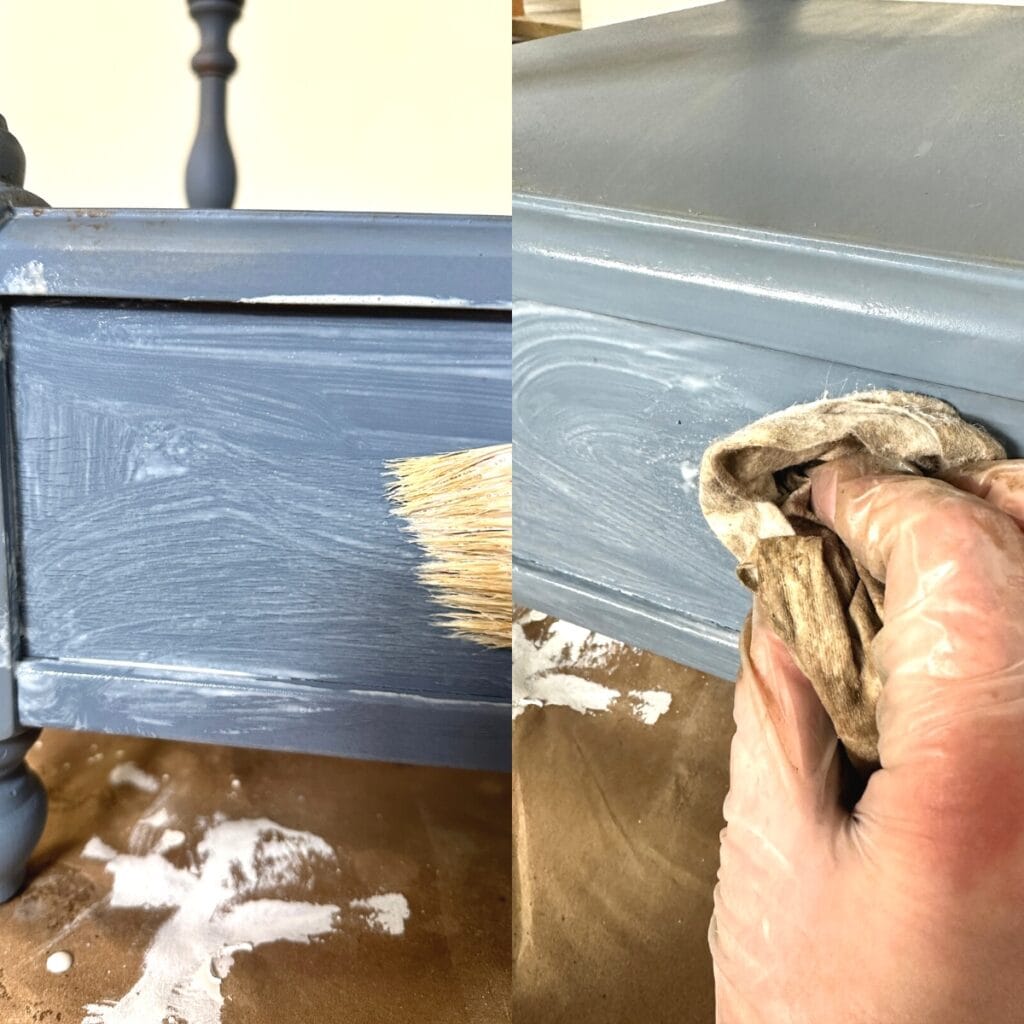
After removing the excess clear wax, immediately apply a small amount of the antiquing wax, focusing on the details and crevices.
Use a clean, lint-free cloth to remove any excess wax and blend the colors together.
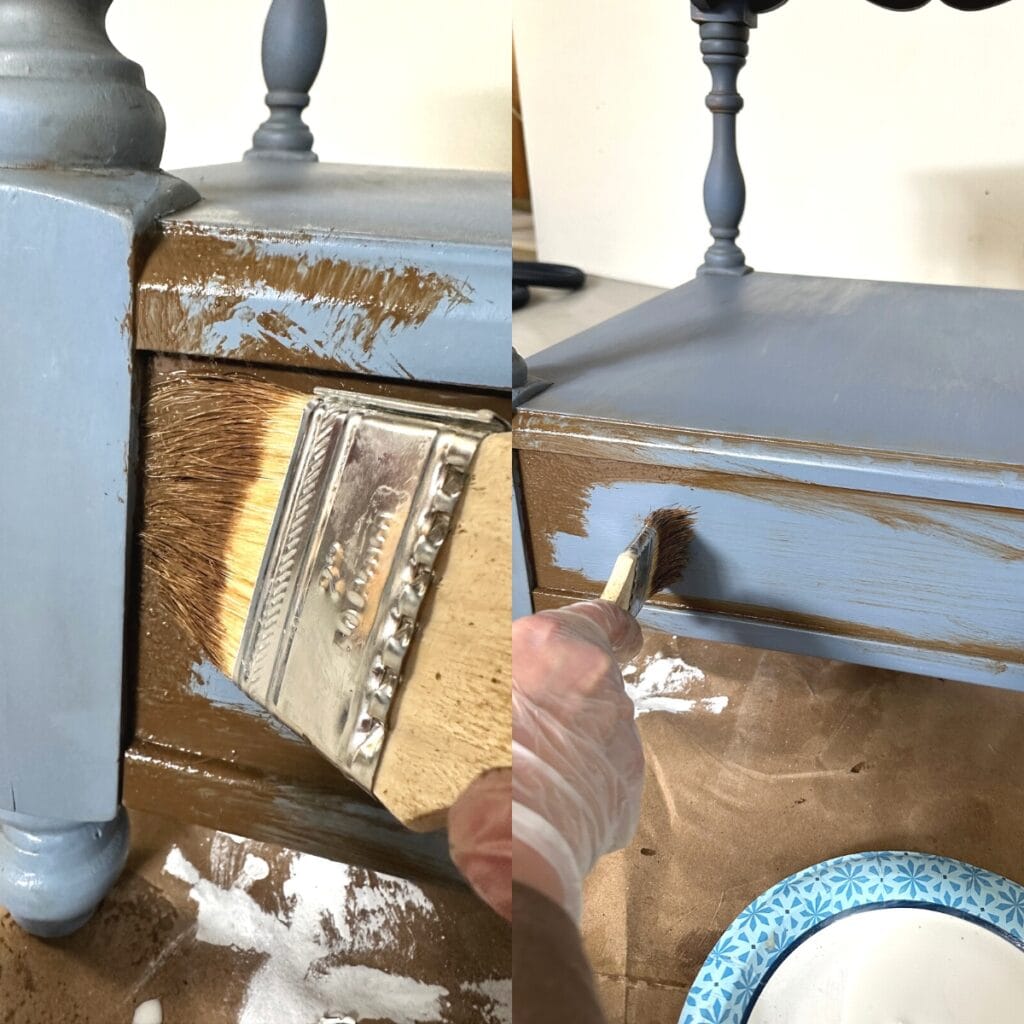
If you got too much dark wax in one area, you can put more clear wax in that area to remove the antique wax.
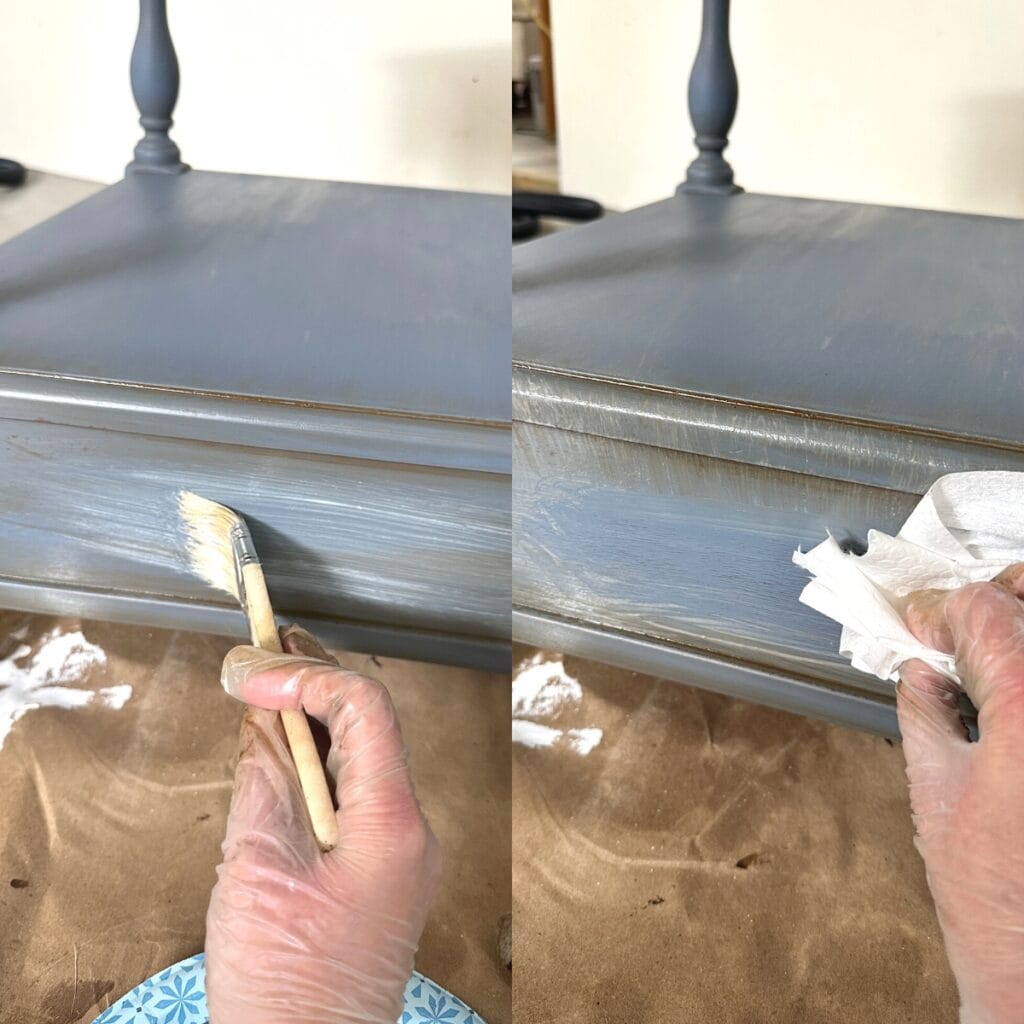
Once you have achieved your desired level of antique texture and depth, let the piece dry for at least 48 hours before using it.
In conclusion, antique waxing over chalk painted furniture is a great way to add character, depth, and texture to any piece.
Check out my guide on How to Use Waverly Antique Wax here.
With a little patience and practice, you can easily master this technique and create stunning, one-of-a-kind furniture pieces that will be the envy of all your friends and family.
Check out this french end table makeover in our How to Use Waverly Chalk Paint and Wax post to see how I use wax over chalk paint.
Glaze VS Wax
When it comes to creating an antiqued chalk paint finish, there are several factors to consider when choosing between glaze and wax.
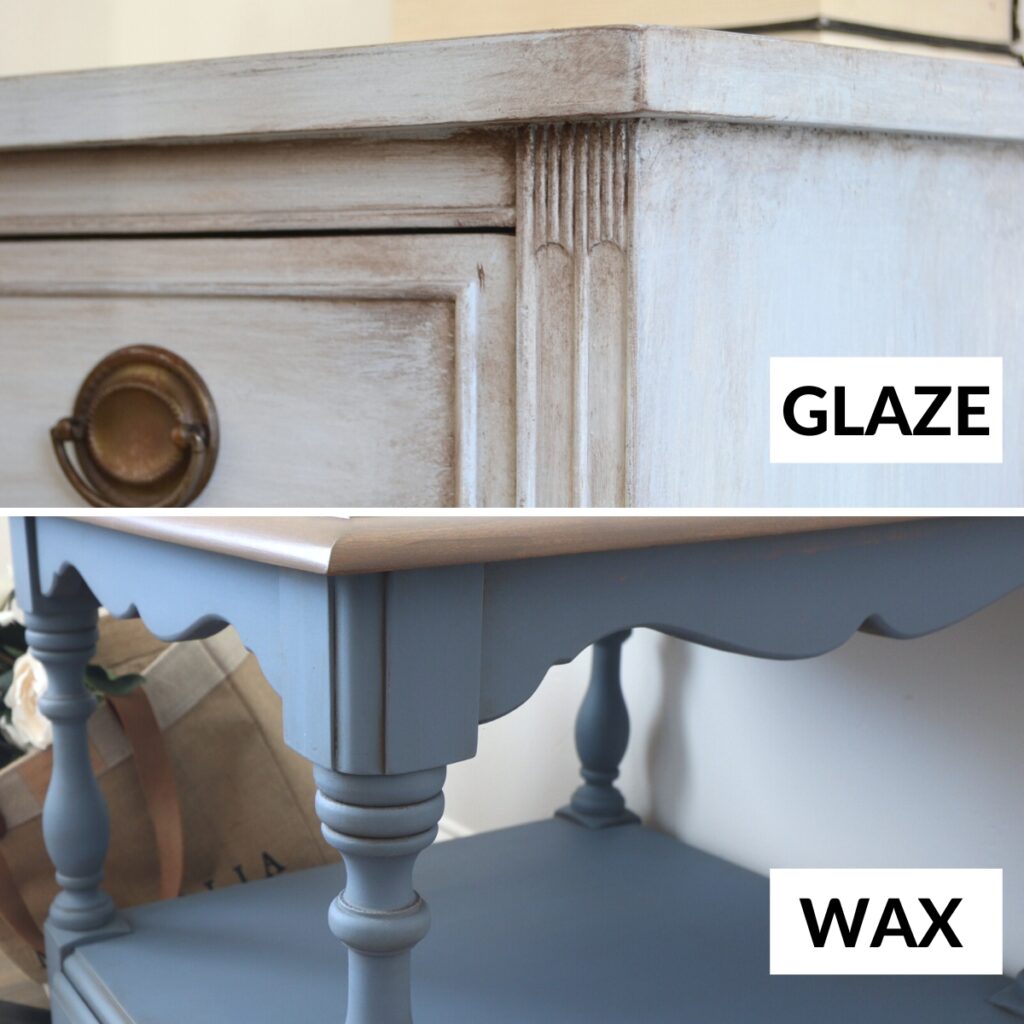
In this closeup comparison, the glaze was put on in multiple layers, with some white and blue glaze layered with the brown.
The closeup of the wax was just 1 light coat of wax.
Ultimately, the decision will depend on the desired finish, the level of durability needed, and personal preference.
Glaze finishes provide a more durable option with a poly topcoat that dries quickly.
This process involves applying a coat of waterbased polyurethane over the chalk paint, letting it dry for 24 hours, and then applying the glaze and letting it dry.
Then you will need to apply additional coats of waterbased polyurethane for maximum durability.
However, it takes longer to glaze and requires a little more skill to apply it properly. Additionally, glaze does not involve wax, which, I for one do not prefer due to the way it feels, how it dries, or how it holds up on furniture.
On the other hand, waxing over chalk paint is a much quicker process than glazing and easier to work with.
This method involves applying a clear wax base coat first, followed by dark wax in areas where desired.
The result is a unique, textured finish that provides both aesthetic appeal and some added durability.
However, it does take longer to dry and is not as durable as a glaze with a water-based polyurethane topcoat.
And in the end, unlike glaze finishes, if the wax finish is not to your liking, the wax must be removed before the furniture can be painted again, which can be time-consuming and require additional effort.
When deciding between glaze and wax, it’s important to consider the specific project at hand. For instance, if durability is a top concern, a glaze finish may be the better option.
In addition, if speed and ease are your top priorities, wax may be the better choice. Ultimately, you should consider their personal preferences and the specific needs of their project before making a decision.
More Glaze and Wax Posts
- Dreamy Blue Painted Dresser
- French Blue Dressers
- Wax For Chalk Paint: Is It The Right Choice For Your Furniture?
- Wax VS Polyurethane
- Painted Light Blue Dresser
Follow us on YouTube to get more tips for painting furniture.
Or share your project with us on our Facebook Group and be part of our community. See you there!

![Furniture Glaze - Antique Patina Special Effects Glaze for Chalk Style Furniture Paint, Eco-Friendly Wood Stain, 6 Color Choices - Graphite [Black] - Pint (16 oz)](https://m.media-amazon.com/images/I/31uHMONH8DL._SL500_.jpg)

